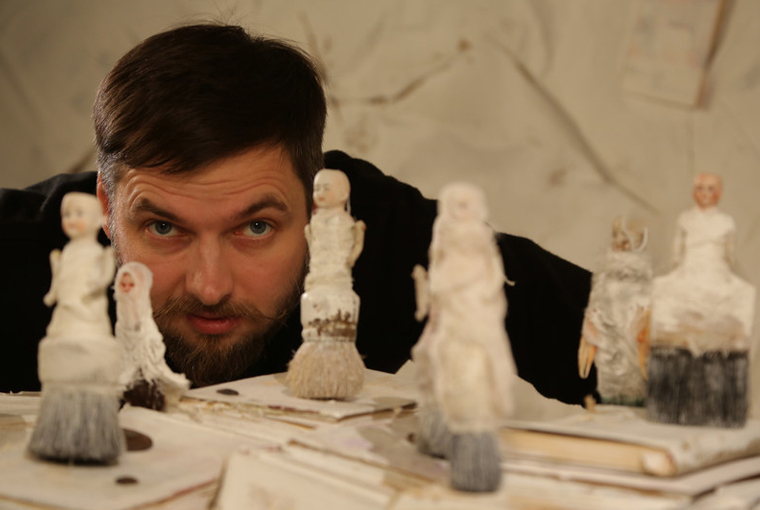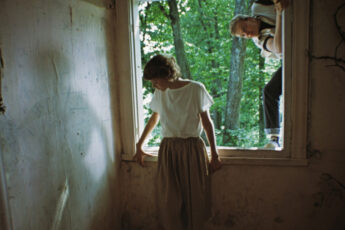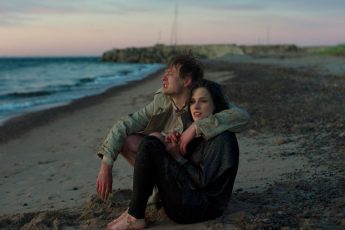
We met Estonian animator Ülo Pikkov at the International Animation Film Festival Animac in Lleida, Spain during a retrospective of his films. Pikkov recounts his transition from hand-drawn animation to stop-motion film and explains his documentary animation approach. He also speaks about the stories behind his most important works, and reveals his passions and artistic influences.
The style of your graduation film Bermuda was influenced by your teacher Priit Pärn. The plot features a sailor and a mermaid who are stranded on the mainland with their boat, waiting for the rain. When a centaur appears, an atmosphere of rivalry unfolds. Who are those characters?
In that period, I was interested in dramaturgical formulas, and in this film, I wanted to build a triangle of relationships. The Bermuda title suggests as much. I thought about the characters in a schematic way: “A” and “B”, the mermaid and the sailor. One depends entirely on the other. The mermaid has no legs and cannot walk, so the sailor takes care of her, brings her water, food, etc. Then character “C” appears, and now the sailor starts to depend on the mermaid. It was a period in which, in addition to being highly influenced by Priit Pärn’s visual style, I was also interested in mathematical formulas that could be used in plot construction: stories of relationships, influences and interdependencies, castings between characters that could be visualized through drawn schemes. Nowadays I think that cinema needs more improvisation so it doesn’t lose its magic. If everything is structured and calculated, the result is too dry.
You would soon abandon mathematical formulas and leave hand-drawn animation behind (with the exception of a collective work entitled Frank and Wendy that you participated in). How did this shift come about?
I have always been interested in experimental cinema and trying out different techniques, the so-called side areas. I knew people working on experimental projects at Nukufilm studio and they invited me to go and work with them. That is how Body Memory was born. Working with puppets is closer to making a movie, to the true cinematographic process, while the production of drawn animation increasingly resembles an office job. I prefer the real world, being able to touch the material. Manual labor is closer to my nature. And because of that, after my first stop-motion movie with puppets, I continued working in that direction. I think that many more discoveries could be made in terms of techniques.
How different would the message of Body Memory have been had you chosen to make it by using hand-drawn animation? Are there things you would not have been able to express with another type of technique?
Initially, I made tests with hand-drawn animation, but it didn’t work. My characters are connected with the past through a thread and in the drawn version it was almost impossible to illustrate the continuity of this connection. When I tried working with puppets, the result was much better. That was the most important reason to further pursue stop-motion. Some visual symbols are much more powerful if they are made of genuine, tactile, three-dimensional materials. Or, perhaps, I’m not that good in hand-drawn animation.
At the beginning of the film I didn’t realize it was about the Stalinist regime, I automatically associated it with Nazi concentration camps. Another of your films, Empty Space, about a father creating a doll house for his daughter while hiding away from Soviet authorities in the basement of his family home, also tackles the topic of Stalinism.
Well, in Estonia, Stalinist terror is still a huge trauma, mainly because people were unable to talk about the events during the 1950s. After the collapse of the Soviet Union these stories started getting revealed and interpreted through artistic narratives. Body Memory works at a universal level and is perfectly understood by everyone. It was very well perceived in Arab countries, for example. I was at a festival in Dubai where the film had won an award and many local people came to tell me that similar things had happened in their town. They could relate on both personal and collective levels, which surprised me, because when we were filming during that single gray and snowy day, we were looking for an authentic Estonian atmosphere.
Tolstoy says that some of his novels contain more meaning than he himself had intended to convey. And I have a similar feeling regarding Body Memory: that this movie is smarter, somehow bigger than me. The effect it produces goes far beyond what I can understand or explain. Sometimes art manages to access a deeper level than the artist himself realizes.
Perhaps that “bigger than me” moment you are talking about are the meanings brought in by spectators with similar experiences. My Soviet Education, on the other hand, is quite serene. It is a joyful associative journey through our memory that preserves fragments of this visual education, the product of which are the generations who grew up behind the Iron Curtain.
I made this film for an exhibition entitled Soviet Visuals, and thanks to the project I was able to access a large collection of those images. The Soviet educational system used lots of slides back in the days, so my idea was to choose some popular ones and show them very rapidly. And yes, I can say that my childhood in the Soviet era was happy, so I do not want to reflect on the period only in dark colors. I’m talking about the 70s and 80s, when the terror was gone, not the 50s, when one could go to prison for saying a political joke. The characteristics of this late period were a certain sense of absurdity and fear of the army. The war in Afghanistan had just started and many young men were afraid of being mobilized. Others went to war and were killed. But overall, it was a quiet period.
Now there is even nostalgia for those times.
Oh, yeah! All the hipsters in Tallinn, my hometown, ride old Soviet bikes; Soviet cars are also in fashion. The Soviet times’ design returns in a recycled form. It seems that each epoch needs a time span of 20-30 years and a change of generations for it to be rediscovered. See what fervor the Chernobyl series has caused. Some kind of cult fetish arises for the aesthetics and lifestyle of those times. But there were also genuine positives. People were poor, but the environment was clean, with few cars and without all that plastic; there were few goods in the supermarket, but the milk was real. It was safer, or at least the media were not paying as much attention to crimes. In many ways, these were genuinely good times for growing up.
Your most experimental film from the retrospective at Animac is Zebra, which contains quite a peculiar phrase: “All the curtains of my life”. What does it refer to?
It has to do with my obsession of collecting objects. I collect all kinds of stuff. For example, I keep the keys that I have used through different stages of my life, as well as the curtains since my university years, during which I switched campuses several times. I wanted to work with analog materials. Inspired by one of my abstract dreams involving zebras, I used various curtains from my collection, printed their patterns directly onto 35mm film strips, and that’s how Zebra was born. The reconstruction of memories was the reason why I wanted to make this short, because I associate those patterns with certain periods of my life. The process of doing it was much more important than the result; the goal was to live to see those memories again. Furthermore, directly handling the film material produces very fast results. Zebra was also made for a gallery. It traveled to festivals, but I don’t consider it a real movie, it was just an experiment for me.
Are the clocks featured in Tik-Tak also part of your collection?
No, but a colleague of mine from the Academy of Arts in Tallinn once mentioned that she had a lot of clocks, and I immediately started to fantasize about what I could do with them. It turned out that her grandfather was a famous clocksmith in the city whose studio was destroyed during the Soviet bombing of the city in 1944. Fortunately, he was not inside his workshop at the time. He managed to save some of the clocks and move them to his basement. When I saw them, they looked so beautiful that I immediately thought of using them in a movie. I found archival photographs of his studio and made the most accurate restoration possible. I also imagined what would have happened if it hadn’t been destroyed. Interestingly, at the same exact spot where the workshop used to stand, there is a movie theater today, where we projected Tik-Tak for several weeks. In this way the clocks returned home. I like that idea of a closed cycle of history. It was the starting point for the film. Another curious event was that some of the clocks started working during filming and at one point a cacophony arose: we wanted to stop the ticking, but we did not know which ones were producing it, they acted as a complete living organism. I felt a living connection to the past through this film.
The theme of a race against time is also present in your latest film, The Tortoise and the Hare. Here too, as in Tik-Tak, time goes backwards.
The Tortoise and the Hare was not really planned as a movie. My mother had gotten cancer, I was taking care of her and was driving her to chemotherapy in another city, about an hour away from Tallinn. I knew it wouldn’t last long and I wanted to have a remembrance of those trips with her. I didn’t want to shoot immediately. If I had used a professional camera, she would have thought that her son had already accepted that her death was near. So I used the camera in the car. In Russia and Estonia, all cars nowadays have dashcams to keep record in case of an accident. When I was seeing her asleep during the trips, I would turn on the camera. After her death, I had actually forgotten about those recordings. Then I downloaded them and while watching them, I remembered the old story about the tortoise and the hare. The story of the slow turtle who defies all the odds to win the race sounds like a metaphor for death to me, which is sometimes closer and sometimes further away, but always around. My mother passed away in the summer. When I reviewed the material after her death, it turned out that I had collected about 15 hours of footage. I started organizing it, then received a little financial help thanks to which I was able to hire a professional sound designer. Sometimes my movies just happen. Or the idea suddenly invades me, haunts me and until I realize it, it doesn’t leave me alone. I do it so to get rid of it. The Tortoise and the Hare was a form of therapy for me. At first it was even difficult to watch the material, but gradually I accepted the situation and in the end I felt much better. The original idea was not therapeutic, but the process turned out to be curative.
In Letting Go, the complex character you created – a puppet made out of books – seems difficult not only to build but also to navigate through space. Why did you decide to create such a puppet?
Several girls from an orphanage visited my studio to watch me working, and at one point we decided to do something together. They were asking questions, participated with suggestions, and the film was born out of a collective process. Some of them were writing diaries and were seeing their lives as books, so thus came the idea of a collective character made up of their diaries. Some of the girls were difficult characters, they would disappear for months, so I mainly worked with Agnes who helped a lot with the dolls and even appears in the movie. Dolls are another obsession of mine. I read in a forum about a German who found pieces of broken dolls in his garden. It turned out that a century ago, there was a small porcelain doll factory where his yard is now, with broken remains dumped in the ground. I explained to the owner that I was working with “broken” people and he gave me a whole box of defective dolls.
How did the girls react to this identification with the notion of “broken” people?
They took it well. I did not insist, nor did we discuss the matter directly. It came naturally. I had provided them with an environment in which they were feeling comfortable. Agnes was very active. She was interested in animation techniques and was enjoying the preparation of the dolls for filming. I think the process was helpful to her. At first she was shy, she didn’t talk to anyone, didn’t even look people in the eyes. But over time she relaxed, began to participate in the process and one day she asked me to record her. While I recorded her, she voiced the idea that if you want to turn a new page in your life, you must be brave enough to look back at the past. Also, at the beginning of the project the girls had discovered a Japanese wisdom: to get rid of some evil, you must make a doll and throw it into the sea. So we created this character out of their diaries, so that we could let him float in the water. But he never sailed, he kept coming back.
Let’s talk a bit about documentary animation, the genre in which you work most often. The term sounds paradoxical at first glance, but your films definitely add meaning to the parameters of the genre. Watching them, we understand very well why you would choose to tell authentic stories with the tools of animation. It is an original way of recreating the past.
For me documentary animation offers many more opportunities than traditional documentary cinema. There are real life objects that are documents themselves. For example, Tik-Tak is more of a documentary than it is an animated short despite the techniques used, because it is like a fragment of life. The idea is inspired by real people, places and events. Empty Space, on the other hand, fits in completely within the term. The dollhouse is a historical and cultural heritage that belongs to the collection of the Toy Museum in Tartu. If I had to define this genre of cinema, I would define it thus: it is an animated film that contains elements of life.
And how do you combine creative work with academic work? In addition to making films, you are also an author of theoretical works: you published Animasophy: Theoretical Writings on the Animated Film as well as your doctoral thesis Anti-Animation: Textures on Eastern European Animated Film.
Theoretical work helps me understand what I do. Writing is a way of organizing my ideas. Documentary animation is a very interesting concept, and I think that if in 50 years we would have to describe the evolution of animation during our times, the appearance of its documentary aspect will probably be the most important aspect within a broader tendency of mingling film genres. Today’s high-budget Hollywood productions, for example, are officially considered fiction films, but many of them are actually animated due to the wide application of visual effects. Each frame is retouched, even the light in it is already digitally generated. 10 years ago, hybrid genres were still considered experimental, but today they make up a significant part of mainstream production. And although I am particularly interested in documentary animation, I don’t like the idea of merging all types of cinema into a universal genre, of losing the boundaries between them. I prefer the light accession, a sort of flirtation between them. The process is a result of new technological capabilities. For the new generations that grew up with video games, this fusion is also quite natural. It is common for them to communicate with someone who is not a real person, or to conduct social activities online. For the previous generations to which me and you belong, all this seems paradoxical, as you said. It will be difficult for us to make an appointment with a virtual doctor or discuss an important issue with an AI entity. But in 20 years it will probably be the norm, and documentary animation will not be questioned either.




Leave a Comment